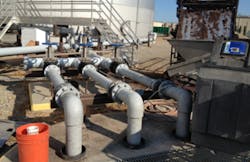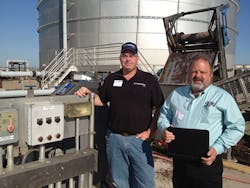The importance of proper pump selection in winemaking is well-documented. Turning grapes (a solid), into wine (a liquid) on a large scale, calls for a number of different specialized pump types for transferring, filtering, and bottling. The entire process of pressing/settling, fermentation, aging, separation, chilling, and bottling are all pump-intensive operations.
But what do you do with the waste created by that process stream?
That dilemma is faced by every domestic vintner and the solutions are different for every one of them depending on where they are situated and the local and federal regulations for that particular location. One Californian winery, producer of premium wines, manages these important issues with keen environmental awareness. Treatment and release of wastewater had to meet their high corporate standards.
With an expanding market for its wide range of varietal wines, production at the winery had to be increased. An effective treatment process, for the wastewater generated by the plant, had to be designed. The challenge of meeting the waste stream demands, as well as maintaining optimum production at peak efficiency, fell to Jason Simpson. Jason is the plant Manager for EcoLabs, the contractor responsible for the operation of the wastewater treatment plant at the winery.
The wastewater system was designed by Ecolabs’ subsidiary in Rochester, NY. Part of the Water, Energy and Waste Solutions division of Ecolab, Ecovation Inc. specializes in water treatment and wastewater treatment solutions to lower operating costs and raise energy efficiency. Working in concert with an engineering firm and hydraulic experts from CPE (Corrosion Products & Equipment), Ecovation designed a system which would collect the maximum output of the plant into a wet well, move the effluent to an equalization tank, through a wastewater reactor, and finally to aerobic holding ponds. The treated wastewater would be used to irrigate the vineyard thus completing a completely “green wastewater process.”
Jake Scherer, vice president of sales, Pump Division of CPE coordinated the pump selection. There were numerous considerations.
Corrosion Resistance—The pumps needed to be corrosion-resistant due to the acidity of the waste media.
Erosion Resistant—Hard metallurgy would be needed to stand up to the coarse solids (stems, pits, etc.) encountered.
Non-Clog Design—As solids settle-out they would tend to clog pumping action.
Minimal Footprint and Self Priming—Using dry-mount pumps would take up too much floor space and need to have reliable priming. Submersible pumps are inherently self-priming and keep cooler being submerged in the liquid.
Reliable—Positioned at the bottom of a deep sump, the pumps would cause operational delays if they needed to be continuously pulled for inspection or maintenance.
Another consideration was providing the capacity needed for year-round volume fluctuation.
Vintage volume could fluctuate dramatically through the year. Daily flow through the plant could vary as much as three-fold (for example from 100,000 gallons per day off season to 300,000 gallons a day during the crushing season). As with most systems, the plant and equipment had to be sized to meet the maximum output.
Scherer decided to specify three BJM Model SKX-150 submersible pumps installed in a triplex arrangement. The triplex lift station is a unique arrangement of three pumps operating in parallel. Choosing three pumps for the sump (instead of one or two larger pumps) increases reliability in the system while also efficiently covering a wide range of operating conditions. The triplex control allows operation of one, two, or all three pumps at a time depending on the changing rate of inflow to the tank. The pumps alternate lead and lag position so they get regular exercise and wear more evenly. There is also a high level alarm.
What makes these BJM pumps a unique solution for handling the grape wastewater process?
Non-cogging—The SKX-type pumps produce a shredding action caused by a cutting impeller with a tungsten carbide tip against a suction plate. The suction plate has an irregular opening with engineered cutting slots to help grab debris and aid the impeller with its shredding action.
Volume and Lift—The non-clog, single-vane impellers are designed for high volume and lift performance, perfect for the wet well application.
Wear Resistance—All wear and "wet" parts (parts exposed to the grape waste) such as impeller, wear-plate, oil housing, pump-housing and inner pump top are made of cast 316 stainless steel material.
Reliability—Three-Seal Motor Protection – The submersible motor is protected by double mechanical seals. Lower seals are made of silicon carbide/silicon carbide and the upper seal is made of carbon/ceramic. An additional lip seal has been installed above the impeller to help prevent abrasives from entering into the seal chamber. Winding protection and (NEMA) Class F motor insulation allows the motor temperature to rise to 230 F, superior to pumps with Class A and B insulation. An automatic switch turns the pump motor off if the temperature and/or amp draw rises too high.
READ ALSO: Pre-Engineered Pump System Effectively Doses Sodium Bisulfite in Water Treatment Process
The final system was installed in 2008. As designed all wastewater flows to the wet well containing three BJM submersible pumps in a series; a lag pump, a lead pump, and a spare. They remain totally submerged for maximum cooling, even at the lowest liquid level.
Effluent flows from the wet well to the EQ (Equalization) Tank and the reactor then into aerobic settling ponds. The wastewater is held there until required for irrigation. Based on content, the ponds are drained and dredged to remove any sludge buildup.
Simpson has been extremely happy with the system’s reliability. “The BJM pumps have been installed for five years and during that period, the only maintenance that was required was a single seal replacement,” he said. “Fortunately the warning system advised of the seal failure and we were able to easily switch to the backup pump while we replaced the seal. There was no slow down or stoppage in production.”
The system keeps the winemaking process going. And, keeps our glasses full.
BJM Pumps (www.bjmpumps.com) is headquartered in Old Saybrook, Conn., and has been providing fluid handling solutions for industrial and municipal services since 1983. Over its 30-year history, BJM Pumps has grown quickly by supplying world class pumps and accessories, priced competitively, through its global network of stocking distributors.




